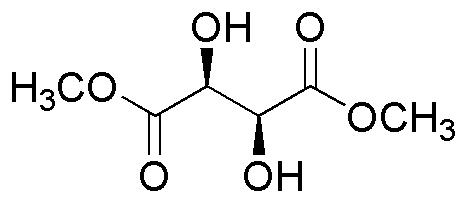D(-)-Dimethyl D-tartrate is widely utilized in research focused on:
- Chiral Synthesis: This compound serves as a chiral building block in the synthesis of pharmaceuticals and agrochemicals, enhancing the production of enantiomerically pure compounds.
- Asymmetric Catalysis: It is used as a ligand in asymmetric catalysis, improving reaction selectivity and efficiency in the production of fine chemicals.
- Food Industry: D(-)-Dimethyl D-tartrate acts as a flavoring agent and stabilizer in food products, contributing to the enhancement of taste and shelf life.
- Biochemical Research: Researchers utilize this compound in studies related to metabolism and enzymatic reactions, providing insights into biological processes.
- Cosmetic Formulations: It is incorporated in cosmetic products for its stabilizing properties, helping to maintain the integrity and effectiveness of formulations.
General Information
Properties
Safety and Regulations
Applications
D(-)-Dimethyl D-tartrate is widely utilized in research focused on:
- Chiral Synthesis: This compound serves as a chiral building block in the synthesis of pharmaceuticals and agrochemicals, enhancing the production of enantiomerically pure compounds.
- Asymmetric Catalysis: It is used as a ligand in asymmetric catalysis, improving reaction selectivity and efficiency in the production of fine chemicals.
- Food Industry: D(-)-Dimethyl D-tartrate acts as a flavoring agent and stabilizer in food products, contributing to the enhancement of taste and shelf life.
- Biochemical Research: Researchers utilize this compound in studies related to metabolism and enzymatic reactions, providing insights into biological processes.
- Cosmetic Formulations: It is incorporated in cosmetic products for its stabilizing properties, helping to maintain the integrity and effectiveness of formulations.
Documents
Safety Data Sheets (SDS)
The SDS provides comprehensive safety information on handling, storage, and disposal of the product.
Product Specification (PS)
The PS provides a comprehensive breakdown of the product’s properties, including chemical composition, physical state, purity, and storage requirements. It also details acceptable quality ranges and the product's intended applications.
Certificates of Analysis (COA)
Search for Certificates of Analysis (COA) by entering the products Lot Number. Lot and Batch Numbers can be found on a product’s label following the words ‘Lot’ or ‘Batch’.
*Catalog Number
*Lot Number
Certificates Of Origin (COO)
This COO confirms the country where the product was manufactured, and also details the materials and components used in it and whether it is derived from natural, synthetic, or other specific sources. This certificate may be required for customs, trade, and regulatory compliance.
*Catalog Number
*Lot Number
Safety Data Sheets (SDS)
The SDS provides comprehensive safety information on handling, storage, and disposal of the product.
DownloadProduct Specification (PS)
The PS provides a comprehensive breakdown of the product’s properties, including chemical composition, physical state, purity, and storage requirements. It also details acceptable quality ranges and the product's intended applications.
DownloadCertificates of Analysis (COA)
Search for Certificates of Analysis (COA) by entering the products Lot Number. Lot and Batch Numbers can be found on a product’s label following the words ‘Lot’ or ‘Batch’.
*Catalog Number
*Lot Number
Certificates Of Origin (COO)
This COO confirms the country where the product was manufactured, and also details the materials and components used in it and whether it is derived from natural, synthetic, or other specific sources. This certificate may be required for customs, trade, and regulatory compliance.

